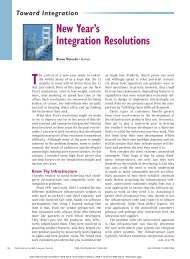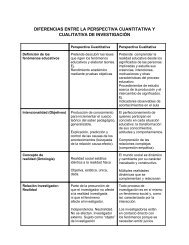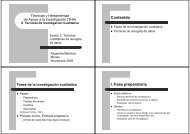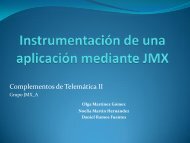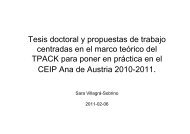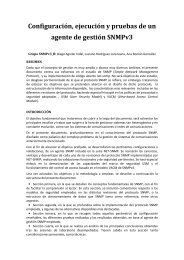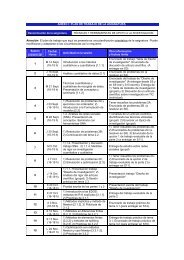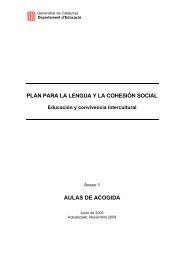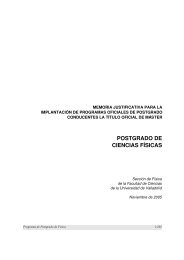Research Questions and Hypotheses
Research Questions and Hypotheses
Research Questions and Hypotheses
You also want an ePaper? Increase the reach of your titles
YUMPU automatically turns print PDFs into web optimized ePapers that Google loves.
166 Designing <strong>Research</strong><br />
Assign participants to matched pairs on the basis of their scores<br />
on the measures described in Step 1.<br />
R<strong>and</strong>omly assign one member of each pair to the experimental<br />
group <strong>and</strong> the other member to the control group.<br />
Expose the experimental group to the experimental treatment<br />
<strong>and</strong> administer no treatment or an alternative treatment to the<br />
control group.<br />
Administer measures of the dependent variables to the experimental<br />
<strong>and</strong> control groups.<br />
6. Compare the performance of the experimental <strong>and</strong> control<br />
groups on the post-test(s) using tests of statistical significance.<br />
Data Analysis<br />
Tell the reader about the types of statistical analysis that will be used<br />
during the experiment.<br />
Report the descriptive statistics calculated for observations <strong>and</strong> measures<br />
at the pre-test or post-test stage of experimental designs. These statistics<br />
are means, st<strong>and</strong>ard deviations, <strong>and</strong> ranges.<br />
Indicate the inferential statistical tests used to examine the hypotheses<br />
in the study. For experimental designs with categorical information<br />
(groups) on the independent variable <strong>and</strong> continuous information on the<br />
dependent variable, researchers use t tests or univariate analysis of variance<br />
(ANOVA), analysis of covariance (ANCOVA), or multivariate analysis<br />
of variance (MANOVA—multiple dependent measures). (Several of these<br />
tests are mentioned in Table 8.3, presented earlier.) In factorial designs,<br />
both interaction <strong>and</strong> main effects of ANOVA are used. When data on a pretest<br />
or post-test show marked deviation from a normal distribution, use<br />
nonparametric statistical tests.<br />
For single-subject research designs, use line graphs for baseline <strong>and</strong><br />
treatment observations for abscissa (horizontal axis) units of time <strong>and</strong> the<br />
ordinate (vertical axis) target behavior. Each data point is plotted separately<br />
on the graph, <strong>and</strong> the data points are connected by lines (e.g., see<br />
Neuman & McCormick, 1995). Occasionally, tests of statistical significance,<br />
such as t tests, are used to compare the pooled mean of the baseline<br />
<strong>and</strong> the treatment phases, although such procedures may violate the<br />
assumption of independent measures (Borg & Gall, 1989).<br />
With increasing frequency, experimental researchers report both statistical<br />
results of hypothesis testing <strong>and</strong> confidence intervals <strong>and</strong> effect<br />
size as indicators of practical significance of the findings. A confidence<br />
interval is an interval estimate of the range of upper <strong>and</strong> lower statistical<br />
values that are consistent with the observed data <strong>and</strong> are likely to contain<br />
the actual population mean. An effect size identifies the strength of the<br />
conclusions about group differences or the relationships among variables in<br />
quantitative studies. The calculation of effect size varíes for different statistical<br />
tests.<br />
Interpreting Results<br />
The final step in an experiment is to interpret the findings in light of the<br />
hypotheses or research questions set forth in the beginning. In this interpretation,<br />
address whether the hypotheses or questions were supported or<br />
whether they were refuted. Consider whether the treatment that was implemented<br />
actually made a difference for the participants who experienced them.<br />
Suggest why or why not the results were significant, drawing on past literature<br />
that you reviewed (Chapter 2), the theory used in the study (Chapter 3),<br />
or persuasive logic that might explain the results. Address whether the results<br />
might have occurred because of inadequate experimental procedures, such as<br />
threats to internal validity, <strong>and</strong> indicate how the results might be generalized<br />
to certain people, settings, <strong>and</strong> times. Finally, indicate the implications of the<br />
results for the population studied or for future research.<br />
Example 8.6 An Experimental Method Section<br />
Quantitative Methods 167<br />
The following is a selected passage from a quasi-experimental study by Enns<br />
<strong>and</strong> Hackett (1990) that denionstrates many of the components in an experimental<br />
design. Their study addressed the general issue of matching client<br />
<strong>and</strong> counselor interests along the dimensions of attitudes toward feminism.<br />
They hypothesized that feminist participants would be more receptive to a<br />
radical feminist counselor than would nonfeminist participants <strong>and</strong> that nonfeminist<br />
participants would be more receptive to a nonsexist <strong>and</strong> liberal feminist<br />
counselor. Except for a limited discussion about data analysis <strong>and</strong> an<br />
interpretation section found in the discussion of their article, their approach<br />
contains the elements of a good method section for an experimental study.<br />
Method<br />
Participants<br />
The participants were 150 undergraduate women enrolled in both lower<strong>and</strong><br />
upper-division courses in sociology, psychology, <strong>and</strong> communications<br />
at a midsized university <strong>and</strong> a community college, both on the west coast.<br />
(The authors described the participants in this study.)<br />
(Contínued)



